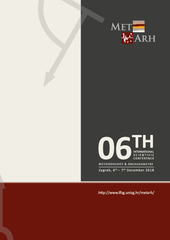Приказ основних података о документу
In chase for traces, Experimental researches of polished stone axes, adzes and chisels and comparative traceological analyses
| dc.creator | Dimić, Vidan | |
| dc.date.accessioned | 2023-11-23T10:17:50Z | |
| dc.date.available | 2023-11-23T10:17:50Z | |
| dc.date.issued | 2018 | |
| dc.identifier.isbn | 978-953-6335-14-5 | |
| dc.identifier.isbn | 978-953-175-745-4 | |
| dc.identifier.uri | http://rai.ai.ac.rs/handle/123456789/806 | |
| dc.description.abstract | Until the end of the 80s, the general knowledge about ground stone edge-cutting tools in the Neolithic of Central Balkan was limited. In various publications, this important category of archaeological material was most often presented in form of cataloging, followed by descriptive and typological determinants, while the function of this tool was completely ignored or it was attributed according to very subjective typol¬ogy. All tools with the cutting edge were interpreted as different types of axes (battle axes, wedge-axes, tongue and mould axes, miniature axes, etc.) while the adzes and chisels were not recognized in the archaeological material. Such a practice, based on subjective observations of the form without detailed analysis, led to errors in the general interpreta¬tion. This situation changed considerably, with the work by D. Antonović and by a radical change in the methodology of exploring this category of stone tools. A different focus of research and incorporation of functional-typological and petrological analyses led to the creation of a significantly larger data pool. Also, new research questions emerged. One of these, not completely solved problems at the global level, is the use-wear on these tools, that is, traceological markers that clearly separate axes, adzes and chisels, as well as markers that are formed on these tools individually in performing various tasks including different factors. There are still no sufficient publications regarding the occurrence and development of these specific damages. Therefore, the author’s doctoral dissertation will focus on the exploration of the traces of the production and use of the mentioned tools through the archaeological experiment. The aim of the research is to form a comprehensive reference database of traceological markers through experimental archaeology as a supporting research method, through which, in the future, a comparison and functional determination of original polished stone tools with a cutting edge would be made. | sr |
| dc.language.iso | en | sr |
| dc.publisher | Zagreb : Faculty of Humanities and Social Sciences of the University of Zagreb | sr |
| dc.publisher | Zagreb : Croatian Archaeological Society | sr |
| dc.relation | info:eu-repo/grantAgreement/MESTD/Basic Research (BR or ON)/177020/RS// | sr |
| dc.rights | openAccess | sr |
| dc.source | 6th International Scientific Conference Methodology & Archaeometry, Zagreb, 6th - 7th December 2018 | sr |
| dc.subject | Polished stone tools | sr |
| dc.subject | axes | sr |
| dc.subject | adzes | sr |
| dc.subject | chisels | sr |
| dc.subject | production and use | sr |
| dc.subject | archaeological experiment | sr |
| dc.subject | use-wear | sr |
| dc.subject | Neolithic | sr |
| dc.title | In chase for traces, Experimental researches of polished stone axes, adzes and chisels and comparative traceological analyses | sr |
| dc.type | conferenceObject | sr |
| dc.rights.license | ARR | sr |
| dc.citation.epage | 50 | |
| dc.citation.spage | 50 | |
| dc.description.other | I. Miloglav (ed.), Book of abstracts of 6th International Scientific Conference Methodology & Archaeometry, 6th ‒ 7th December 2018, Zagreb, Croatia | sr |
| dc.identifier.fulltext | http://rai.ai.ac.rs/bitstream/id/1835/bitstream_1835.pdf | |
| dc.identifier.rcub | https://hdl.handle.net/21.15107/rcub_rai_806 | |
| dc.type.version | publishedVersion | sr |


